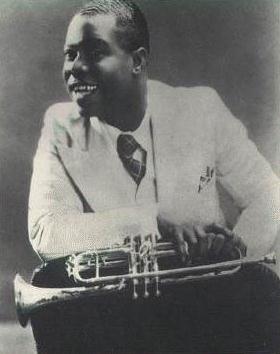|
When Louis Armstrong joined Fletcher Henderson's orchestra in 1924, it marked the beginning of his career as a soloist. From the beginning, Louis' solos dominated the rest of the orchestra, despite the fact that he was a rookie in an immensely popular and well-established band, staffed with the best jazz musicians Henderson could find. Even at this early stage, Louis' solos had a characteristic sound that remained with him throughout his most creative years.
|
MANDY MAKE UP YOUR MIND (1924)
In November 1924 the band recorded "Mandy, make up your mind". Listening to
this performance, it is obvious that Louis is on a different plane than the
rest of the band. Who would want to take a solo following this guy! I wonder
what the other players were saying among themselves about this new phenomenon.
Louis played a prepared solo here, performing it identically on two separate takes. Still, the
sound is clearly Louis' characteristic style even at this early stage.
Statement of the theme by the whole orchestra (MP3, 101k)
Louis' solo (MP3, 137k)
There are several characteristics of this solo that typify Louis during the hot jazz years:
- Beginning in the fourth full measure of the solo, Louis plays a descending arpeggio pattern (F 9th arpeggio in this case) descending to the seventh of the chord (Eb against the F7 chord) followed by an ascending 7th interval (low Db to C). This pattern recurs in his solos throughout the hot jazz years.
- Note how Louis insists on variety in his rhythms and phrasing in contrast to the ensemble. In the original statement of the theme by the ensemble, there is a phrasing pattern of two measures (1-2,3-4 etc with a higher-level phrase grouping of 1-2-3-4,5-6-7-8). However, in the beginning of Louis' solo, his phrases break in a different pattern: 1-2a ,2-3, 4-5, 6-7. This is perhaps what one would expect, given his background as a second cornet under King Oliver, playing countermelody fills in the open spaces of Oliver's lead. But Louis employed this frequently in his solos, always seeking variety of rhytm and phrasing.
- For more rhythmic variety, in 9-10, he introduces some surprising syncopation which is a dramatic break from the strict meter of the original.
- Listen to Louis' individual notes. Each note has a life of its own, with forward momentum and purpose, as if on a mission. He is not content to just play the right pitch at the right time. Instead the note moves forward from beginning to end, sometimes with widening vibrato, other times with bending pitch, yet other times with changing tonal quality. Each note SAYS SOMETHING.
|
GO 'LONG MULE (1924)
Louis' solo (MP3, 83k)
In the first full measure of the solo (then again in measures 5 and 9), you have a simple three quarter-note pattern (daht-daht-dah) which is a common theme in Louis' hot jazz solos.
Note the use of the vibrato / semi-shake on the sustained notes. This is a strong identifying mark of Louis' solos.
|
HOW COME YOU DO ME LIKE YOU DO (1924)
Louis' solo (MP3, 73k)
Note the previously mentioned daht-daht-dah quarter note pattern, and the use of vibrato
Another characteristic found here is the rip up to a high note (in the fourth measure). This occurs in a multitude of later solos by Louis, noteably in some of the most effective breaks (Potato Head Blues is a good example)
|
TEXAS MOANER (1925)
Texas Moaner Blues was recorded when Louis was playing with Clarence Williams' Blue Five.
Louis' solo (MP3, 169k)
Note the descending arpeggio run in measure three, headed for the 7th of the chord. This is a variant of the pattern seen in Mandy above, omitting the interval jump in the following measure.
Here in measures 7 and 8 we see an example of a double-time break.
In the very deliberate tempo of this blues number, Louis cranks up the tension
by improvising at double tempo, then slides smoothly back into the prevailing
tempo at the end of the second measure. Louis employs this technique in many of
his later solos.
|
I AIN'T GONNA PLAY NO SECOND FIDDLE (1925)
This number was recorded while playing with Perry Bradford's Jazz Phools in late 1925.
Louis' solo (MP3, 85k)
In measure 7 (not counting the pickup measure with the triplet quarter notes), we have once again the descending arpeggio to the 7th of the chord (this time a Bb against a C chord).
There are three of examples of the rip up to a high note in this solo, in measures 4 (to F), 6 (to A), and 10 (to G)
Note also that Louis is starting to extend his upper range in this solo, wailing a high Bb ("high C" on the Bb trumpet/cornet) which was unusual for his day. During the next couple of years we'll notice him extending a note or two beyond that. While this is not considered extremely high today, it was in the 1920's. In his day, among jazz cornets and trumpets, only Jabbo Smith rivaled Louis in the use of the high range.
|
